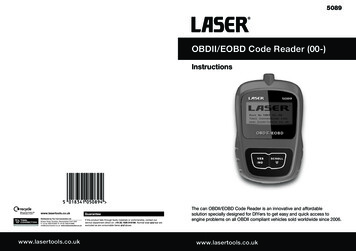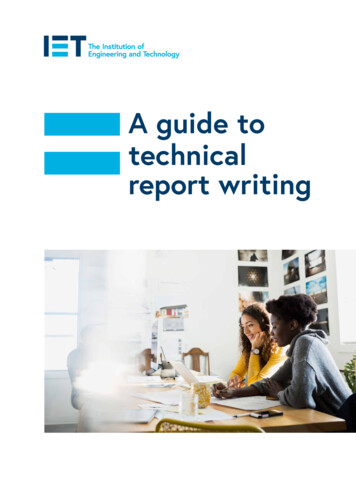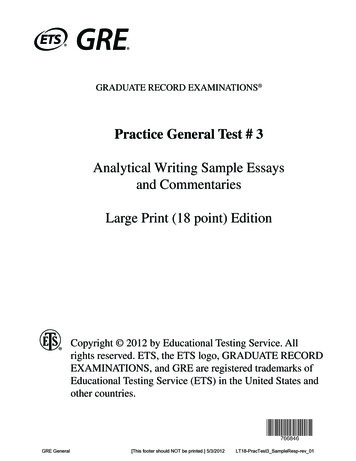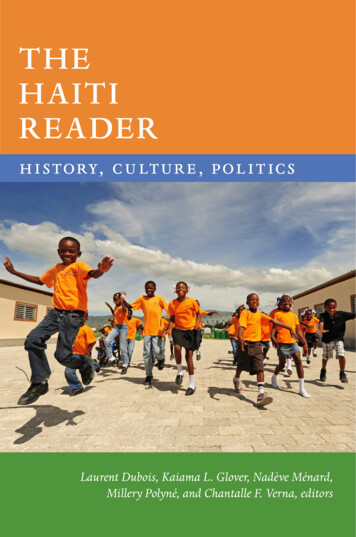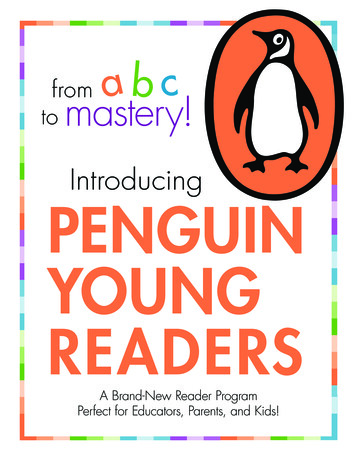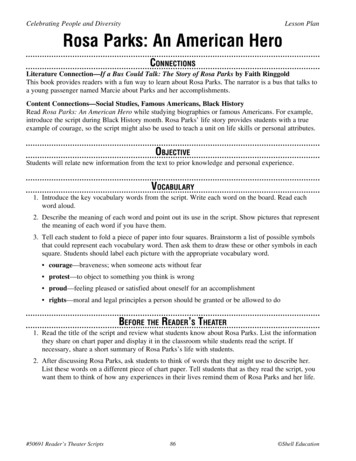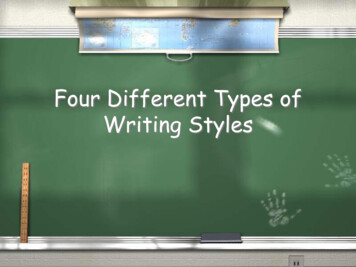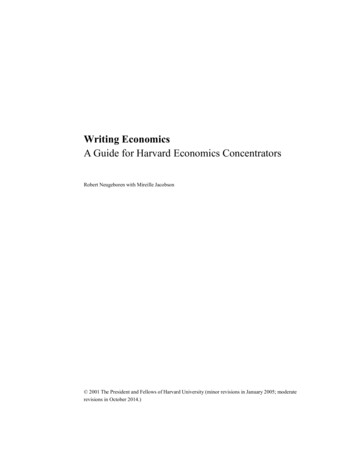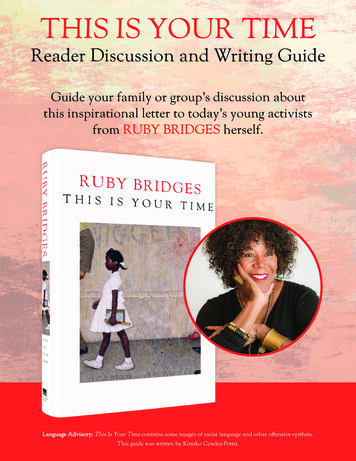
Transcription
THIS IS YOUR TIMEReader Discussion and Writing GuideArt used under license from Shutterstock.com. Photo courtesy of author.Guide your family or group’s discussion aboutthis inspirational letter to today’s young activistsfrom RUBY BRIDGES herself.Language Advisory: This Is Your Time contains some images of racist language and other offensive epithets.This guide was written by Kimiko Cowley-Pettis.
A Brief Overview of theCivil Rights Movement in AmericaTHE FIGHT TO END THE SEGREGATION OF PUBLIC FACILITIESMay 18,1896The Supreme Court made a ruling in thePlessy v. Ferguson case that establishedthe separate but equal doctrine.President Lyndon Johnson signed theCivil Rights Act of 1964, outlawingracial discrimination in employment,voting, and the use of public facilities.July 2,1964TIMELINE OF THE FIGHT FOR SCHOOL INTEGRATIONMay 17,19541960Black and white children went to separateschools in New Orleans. A judge orderedthat four black girls attend two all-whiteschools—McDonogh Elementary Schooland William Frantz Elementary School.One of these girls was RUBY BRIDGES.BRIDGESThe US Supreme Court ruled inBrown v. the Board of Educationthat segregation is unconstitutional.Look at the cover of This Is Your Time. This paintingwas created by Norman Rockwell in 1964 and is titledThe Problem We All Live With. It is consideredan iconic image of the civil rights movement.Turn to the Image Credits page of the book to readmore about the history of this painting and aboutNorman Rockwell.Art used under license from Shutterstock.comDecember 4,1849The Massachusetts Supreme Courtheard arguments about schoolsegregation in Roberts v. the Cityof Boston. Months later, it declaredthat school integration wouldonly increase racial prejudice.
Key Termsfor Your Guided Discussionbigotry: obstinate or unreasonable attachment to a belief, opinion, or faction; inparticular, prejudice against a person or people on the basis of their membership of aparticular groupdesegregation: the ending of a policy of separationfederal marshal: an officer responsible for carrying out law enforcement on behalf ofthe federal courtsintegration: bringing separate people or things togetherJim Crow laws: a collection of state and local statutes that legalized racial segregationMarch on Washington: a massive protest march that occurred on August 28, 1963,when 250,000 people gathered in front of the Lincoln Memorial in Washington, DCprotest: express an objection to what someone has said or doneracism: a belief that race is a fundamental determinant of human traits and capacitiesand that racial differences produce an inherent superiority of a particular raceracist: a person who is prejudiced against or antagonistic toward people on the basis oftheir membership in a particular racial or ethnic group, typically one that is a minority orresilience: the capacity to recover quickly from difficulties; toughnessunrest: a state of dissatisfaction, disturbance, and agitation in a group of people,typically involving public demonstrations or disorderArt used under license from Shutterstock.comis marginalized
Discussion Questions1. Explain how Ruby’s parents (Lucille Bridges and Abon Bridges) were courageous.2. Why would the National Guard be needed to escort a kindergartner to school?3. What criteria did Ruby meet in order to be accepted as the first black child to desegregatethe all-white William Frantz Elementary School?4. Why did some white adults hate Ruby Bridges?5. What character traits do you think Ruby Bridges’s teacher possessed? Why?6. Watch this video of Ruby Bridges (https://youtu.be/hzuS8CI-sSI) reflecting on herexperience integrating William Frantz Elementary School. If you were Ruby Bridges,would you want to attend William Frantz Elementary School the following the schoolyear? Share your thought process.7. How would you describe US Marshal Charles Burks, one of them men who escortedRuby Bridges to school?8. Dr. Robert Coles was a psychiatrist who volunteered to work with Ruby Bridges.Put yourself in Ruby’s shoes. What do you think it was like to walk to school?What type of social or emotional trauma do you think Ruby had to deal with?9. Why do you think Ruby titled her book This Is Your Time?11. How does Ruby’s story contribute to the development of the theme?12. If you could interview Ruby Bridges, what would you ask her?13. How do the images in the book help you understand Ruby’s experience?Art used under license from Shutterstock.com10. What is the central theme of this book?
Further MaterialsClick through the embedded links for additional articles on this topic! “School Segregation and Integration” from the Library of Congress “The Secret to School Integration” by Halley Potter and Kimberly Quick “Why School Integration Matters” by Pedro A. Noguera “Youth in the Civil Rights Movement” from the Library of Congress “Nearly Half of New York City’s Public-School Students Stayed Home to Protest:Segregation in a 1964 Boycott. That Fight Is Still Unfinished” by Olivia B. Waxman “The Largest Civil Rights Protest You’ve Never Heard Of: Teaching the 1964 NewYork City School Boycott” by Adam SanchezSupplemental Books for DiscussionPicture Books Thurgood by Jonah Winter Memphis, Martin, and the Mountaintop by Alice Faye Duncan Lift as You Climb: The Story of Ella Baker by Patricia Hruby PowellMiddle Grade The Watsons Go to Birmingham—1963 by Christopher Paul Curtis The Talk: Conversations About Race, Love & Truth edited by Wade Hudson andCheryl Willis Hudson Stamped: Racism, Antiracism, and You by Jason Reynolds and Ibram X. Kendi One Crazy Summer by Rita Williams-Garcia The Promise of Change by Jo Ann Allen Boyce and Debbie Levy The Power of One: Daisy Bates and the Little Rock Nine by Dennis B. Fradin andJudith FradinPhoto used under license from Shutterstock.com The Lions of Little Rock by Kristin Levine
Further Materials Continued Tell All the Children Our Story: Memories and Mementos of Being Young andBlack in America by Tonya BoldenFor Older Readers The March Trilogy by John Lewis, Andrew Aydin, and Nate Powell Warriors Don’t Cry: A Searing Memoir of the Battle to Integrate Little Rock’sCentral High by Melba Pattillo Beals Understanding and Teaching the Civil Rights Movement by Hasan Kwame Jeffries How to Be Less Stupid About Race by Crystal Fleming So You Want to Talk About Race by Ijeoma OluoSupplemental Films for Discussion The Ernest Green Story (1993) is a docudrama detailing the story of Ernest Greenand eight other African American high school students (known as the Little RockNine) as they embarked on their historic journey to integrate Little Rock CentralHigh School in Little Rock, Arkansas, in 1957. Ruby Bridges (1998) tells the story of one of the first African American children tointegrate a school in the Deep South. Soundtrack for a Revolution (2009) is a documentary that traces the history of thecivil rights movement through its music. Voices from the Black Lives Matter Protests (2020) is an oral and visualrecounting of the fourteen days that followed the murder of George Floyd. FromMinnesota politicians and friends of the victim to activists at the front lines ofthe Black Lives Matter protests, rallies, and marches, we hear from pivotal voiceswho paint a picture of the beginnings of a revolution.Photo used under license from Shutterstock.com Selma (2014) is a historical drama based on the 1965 voting rights marches fromSelma, Alabama, to Montgomery, Alabama.
Ruby Bridges to school? 8. Dr. Robert Coles was a psychiatrist who volunteered to work with Ruby Bridges. Put yourself in Ruby’s shoes. What do you think it was like to walk to school? What type of social or emotional trauma do you think Ruby had to deal with? 9. Why do you think Ruby

